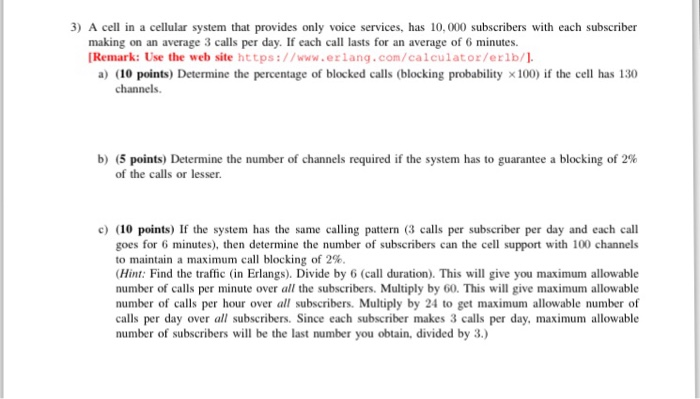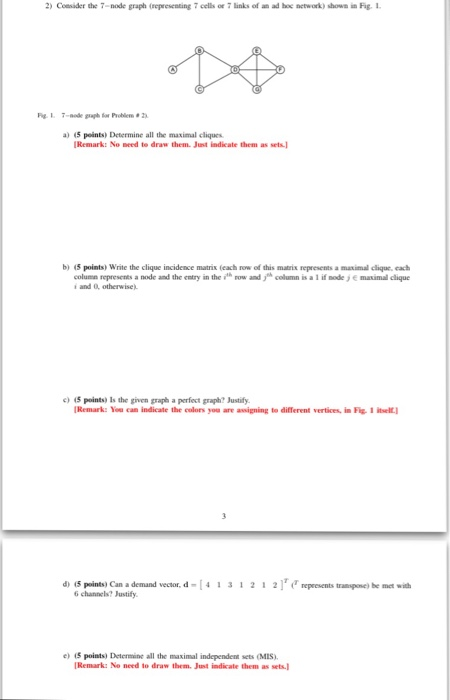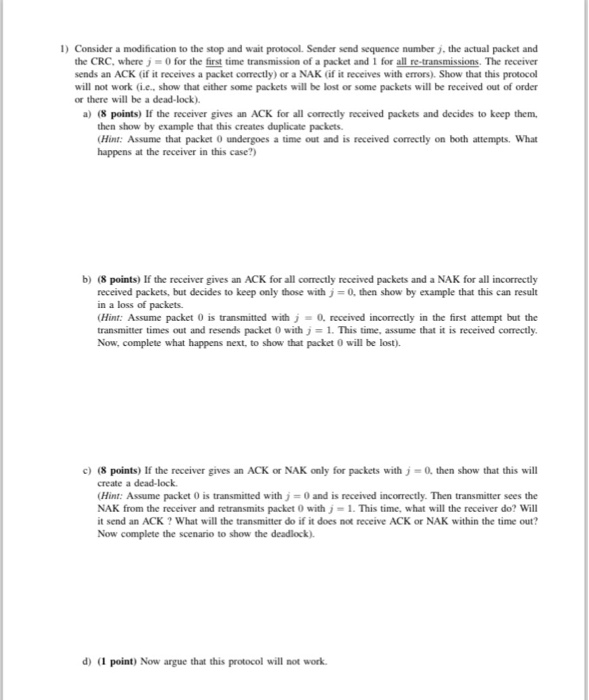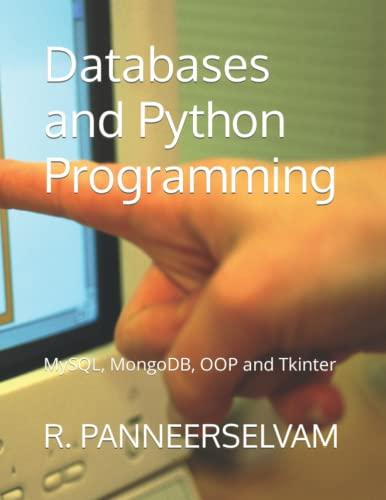3) A cell in a cellular system that provides only voice services, has 10,000 subscribers with each subscriber making on an average 3 calls per day. If each call lasts for an average of 6 minutes. Remark: Use the web site https://www.erlang.com/calculator/erlb/1 a) (10 points) Determine the percentage of blocked calls (blocking probability x 100) if the cell has 130 channels b) (5 points) Determine the number of channels required if the system has to guarantee a blocking of 2% of the calls or lesser. c)(10 points) If the system has the same calling pattern (3 calls per subscriber per day and each call goes for 6 minutes), then determine the number of subscribers can the cell support with 100 channels to maintain a maximum call blocking of 2%. Hint: Find the traffic (in Erlangs). Divide by 6 (call duration). This will give you maximum allowable number of calls per minute over all the subscribers. Multiply by 60-This will give maximum allowable number of calls per hour over all subscribers. Multiply by 24 to get maximum allowable number of calls per day over all subscribers. Since each subscriber makes 3 calls per day, maximum allowable number of subscribers will be the last number you obtain, divided by 3.) 2) Consider the 7-node graph (representing 7 cells or 7 links of an ad hoc nctwork) shown in Fig. 1 a) (5 points) Determine all the maximal cliques Remark: No need to draw them. Junt indicate them as sets b) 45 points) Write the clique incidence matrix (each now of this matrix represents a maximal clique, each column is a 1 ifmodejemaumal dique column represents a node and the eary inthe-^ mw and i and 0, otherwise. c) 45 points) Is the given graph a perfect graph? Justify Remark: You can indicate the colors you are assigning to different vertices, in Fig 1 itselt. d)15 peints) Can a demand vector, d-[41 3 1 2 2]r (r represents transpose) be met with 6 channels? Justify e)(5 points) Determine all the maximal independent sets (MIS Remark: No need to draw them. Just indicate them as sets. 1) Consider a modification to the stop and wait protocol. Sender send sequence number j. the actual packet and the CRC. where 0 for the first time transmission of a packet and 1 for all re-transmissions. The receiver sends an ACK (if it receives a packet comectly) or a NAK (if it receives with errors). Show that this protocol will not work (i.e.. show that either some packets will be lost or some packets will be received out of order or there will be a dead-lock). a) (8 points) If the receiver gives an ACK for all correctly received packets and decides to keep them, then show by example that this creates duplicate packets. Hin: Assume that packet 0 undergoes a time out and is received correctly on both attempts. What happens at the receiver in this case?) b) (8 points) If the receiver gives an ACK for all corectly received packets and a NAK for all incorrectly received packets, but decides to keep only those with j 0, then show by example that this can result in a loss of packets. (Hint: Assume packet 0 is transmitted with j 0. received incorrectly in the first attempt but the transmitter times out and resends packet 0 with j I. This time, assume that it is received correctly. Now, complete what happens next, to show that packet 0 will be lost). c) (8 points) If the receiver gives an ACK or NAK only for packets with -0, then show that this will create a dead-lock (Hint: Assume packet 0 is transmitted with 0 and is received incorrectly. Then transmitter sees the NAK from the receiver and retransmits packet O with j = 1-This time, what will the receiver do? Will it send an ACK? What will the transmitter do if it does not receive ACK or NAK within the time out? Now complete the scenario to show the deadlock). d) (1 point) Now argue that this protocol will not work 3) A cell in a cellular system that provides only voice services, has 10,000 subscribers with each subscriber making on an average 3 calls per day. If each call lasts for an average of 6 minutes. Remark: Use the web site https://www.erlang.com/calculator/erlb/1 a) (10 points) Determine the percentage of blocked calls (blocking probability x 100) if the cell has 130 channels b) (5 points) Determine the number of channels required if the system has to guarantee a blocking of 2% of the calls or lesser. c)(10 points) If the system has the same calling pattern (3 calls per subscriber per day and each call goes for 6 minutes), then determine the number of subscribers can the cell support with 100 channels to maintain a maximum call blocking of 2%. Hint: Find the traffic (in Erlangs). Divide by 6 (call duration). This will give you maximum allowable number of calls per minute over all the subscribers. Multiply by 60-This will give maximum allowable number of calls per hour over all subscribers. Multiply by 24 to get maximum allowable number of calls per day over all subscribers. Since each subscriber makes 3 calls per day, maximum allowable number of subscribers will be the last number you obtain, divided by 3.) 2) Consider the 7-node graph (representing 7 cells or 7 links of an ad hoc nctwork) shown in Fig. 1 a) (5 points) Determine all the maximal cliques Remark: No need to draw them. Junt indicate them as sets b) 45 points) Write the clique incidence matrix (each now of this matrix represents a maximal clique, each column is a 1 ifmodejemaumal dique column represents a node and the eary inthe-^ mw and i and 0, otherwise. c) 45 points) Is the given graph a perfect graph? Justify Remark: You can indicate the colors you are assigning to different vertices, in Fig 1 itselt. d)15 peints) Can a demand vector, d-[41 3 1 2 2]r (r represents transpose) be met with 6 channels? Justify e)(5 points) Determine all the maximal independent sets (MIS Remark: No need to draw them. Just indicate them as sets. 1) Consider a modification to the stop and wait protocol. Sender send sequence number j. the actual packet and the CRC. where 0 for the first time transmission of a packet and 1 for all re-transmissions. The receiver sends an ACK (if it receives a packet comectly) or a NAK (if it receives with errors). Show that this protocol will not work (i.e.. show that either some packets will be lost or some packets will be received out of order or there will be a dead-lock). a) (8 points) If the receiver gives an ACK for all correctly received packets and decides to keep them, then show by example that this creates duplicate packets. Hin: Assume that packet 0 undergoes a time out and is received correctly on both attempts. What happens at the receiver in this case?) b) (8 points) If the receiver gives an ACK for all corectly received packets and a NAK for all incorrectly received packets, but decides to keep only those with j 0, then show by example that this can result in a loss of packets. (Hint: Assume packet 0 is transmitted with j 0. received incorrectly in the first attempt but the transmitter times out and resends packet 0 with j I. This time, assume that it is received correctly. Now, complete what happens next, to show that packet 0 will be lost). c) (8 points) If the receiver gives an ACK or NAK only for packets with -0, then show that this will create a dead-lock (Hint: Assume packet 0 is transmitted with 0 and is received incorrectly. Then transmitter sees the NAK from the receiver and retransmits packet O with j = 1-This time, what will the receiver do? Will it send an ACK? What will the transmitter do if it does not receive ACK or NAK within the time out? Now complete the scenario to show the deadlock). d) (1 point) Now argue that this protocol will not work









